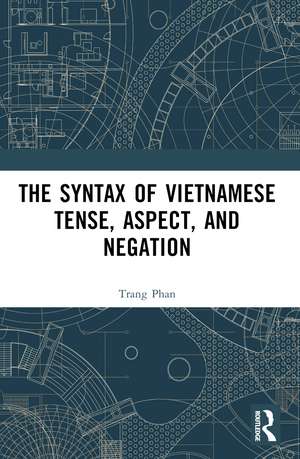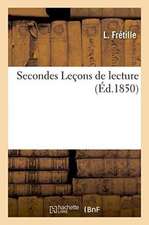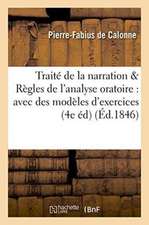The Syntax of Vietnamese Tense, Aspect, and Negation
Autor Trang Phanen Limba Engleză Paperback – 28 noi 2024
The purpose of this book is to thoroughly examine how these categories are realised and how they interact with one another in Vietnamese in the spirit of Generative Grammar, in particular, the Cartographic approach to syntax and its most recently developed lexicalisation technique, Nanosyntax. It is concluded that despite lacking inflectional tense, Vietnamese does have syntactic tense, i.e., Vietnamese has those structural positions which are dedicated to Tense and Aspect. In fact, Tense and Aspect in Vietnamese are realised via a rigid fine-grained functional sequence which syntacticises subtle semantic distinctions both preverbally and post-verbally. There is a two-way complicated relationship between Negation and Aspect in Vietnamese, which can be explained in a principled way by taking into consideration how the internal syntax of the temporal, aspectual, and negative markers derives their clausal syntax. This book also discusses how Vietnamese Tense, Aspect, and Negation pattern with, and differ from, their counterparts in Western Indo-European languages, and how this study contributes to a better understanding of East and mainland Southeast Asian languages more generally, as well as of language universally.
This book will be of interest to both undergraduate and postgraduate students of contemporary linguistics, and for scholars interested in contemporary approaches to Vietnamese linguistics, and Southeast Asian languages more generally.
| Toate formatele și edițiile | Preț | Express |
|---|---|---|
| Paperback (1) | 381.81 lei 6-8 săpt. | |
| Taylor & Francis – 28 noi 2024 | 381.81 lei 6-8 săpt. | |
| Hardback (1) | 1001.70 lei 6-8 săpt. | |
| Taylor & Francis – 28 iul 2023 | 1001.70 lei 6-8 săpt. |
Preț: 381.81 lei
Nou
Puncte Express: 573
Preț estimativ în valută:
73.06€ • 78.13$ • 60.92£
73.06€ • 78.13$ • 60.92£
Carte tipărită la comandă
Livrare economică 17 aprilie-01 mai
Preluare comenzi: 021 569.72.76
Specificații
ISBN-13: 9781032482682
ISBN-10: 1032482680
Pagini: 182
Dimensiuni: 156 x 234 mm
Greutate: 0.27 kg
Ediția:1
Editura: Taylor & Francis
Colecția Routledge
Locul publicării:Oxford, United Kingdom
ISBN-10: 1032482680
Pagini: 182
Dimensiuni: 156 x 234 mm
Greutate: 0.27 kg
Ediția:1
Editura: Taylor & Francis
Colecția Routledge
Locul publicării:Oxford, United Kingdom
Public țintă
Academic, Postgraduate, and Undergraduate AdvancedRecenzii
‘There is tense in “tenseless” languages. This book investigates key aspects of the clause structure of an understudied language in a remarkably clear and insightful way. It’s a beautiful example of the richness of modern generative linguistics. Also Vietnamese now becomes a protagonist in the exciting debate on the nature of crosslinguistic variation.’
- Professor Gennaro Chierchia, Harvard University.
‘This book is of a very high value, not just for researchers specializing in Vietnamese linguistics, but clearly for all theoretical linguists. Vietnamese is a language of a very specific type; it is an analytic language with no inflection typically wearing its logical structure on its sleeves. As such, results arrived at for Vietnamese will very often have direct repercussions for the analysis of other languages as well.’
- Prof. Dr. Daniel Hole, University of Stuttgart
- Professor Gennaro Chierchia, Harvard University.
‘This book is of a very high value, not just for researchers specializing in Vietnamese linguistics, but clearly for all theoretical linguists. Vietnamese is a language of a very specific type; it is an analytic language with no inflection typically wearing its logical structure on its sleeves. As such, results arrived at for Vietnamese will very often have direct repercussions for the analysis of other languages as well.’
- Prof. Dr. Daniel Hole, University of Stuttgart
Cuprins
PREFACE
ABBREVIATIONS
CHAPTER 1: INTRODUCTION
1. Objectives
2. Why Vietnamese Tense, Aspect, and Negation?
3. Research questions
4. Theoretical assumptions
5. Outline of the book
CHAPTER 2: SYNTACTICISING TENSEDNESS
1. Introduction
2. Theoretical background
3. Non-peripherality
4. Non-optionality
5. The hierarchy of tense and aspect
6. Other properties associated with tensedness
6.1. Bare predicates
6.2. Finiteness
6.3. Expletive subjects
7. Conclusion
CHAPTER 3: DECOMPOSING THE PERFECT
1. Introduction
2. Theoretical background
3. The semantic compositionality of đã
3.1. Achievements and đã
3.2. States and đã
3.3. Activities and đã
3.4. Accomplishments and đã
3.5. Discussion
4. The interaction between đã and negative/interrogative markers không/chýa
4.1. Đã in the absence of negative không/chưa
4.2. Đã in the presence of negative không/chưa
4.3. Đã in the presence of interrogative không/chưa
4.4. Discussion
5. The Interaction between đã and other preverbal elements
6. Conclusion
CHAPTER 4: CALCULATING TELICITY
1. On the compositionality of telicity in Vietnamese
1.1. Inherently telic verbs
1.2. Telic particles
1.3. Numeral direct object
1.4. Other factors
2. The syntactic projection of telicity in Vietnamese
3. Immediate consequence: Thematic hierarchy in causatives
4. Extension
5. Conclusion
CHAPTER 5: DECOMPOSING THE NEGATORS
1. Introduction
2. Negation and Lexical Aspect
3. Negation and Grammatical Aspect: the differences between không and chưa
4. Negation and Interrogativity
4.1. A cross-linguistic perspective
4.2. The similarities between negative không/chưa and interrogative không/chưa
4.3. Differences between negative không/chưa and interrogative không/chưa
4.4. A proposal for the featural make-up of không and chưa
5. Conclusion
CHAPTER 6: EXPLAINING THE NEGATION CONSTRAINT ON ASPECT
1. Introduction
2. Previous accounts
3. Explaining the negation constraint: The Nanosyntactic approach
4. Conclusion
CHAPTER 7: FINAL REMARKS
1. Does Vietnamese have Tense?
2. What is the functional sequence of Aspect markers in Vietnamese?
3. How does Negation interact with Tense Aspect in Vietnamese?
4. What does this study of Vietnamese TAN contribute to a better understanding of East and mainland Southeast Asian languages as well as of language more universally?
ABBREVIATIONS
CHAPTER 1: INTRODUCTION
1. Objectives
2. Why Vietnamese Tense, Aspect, and Negation?
3. Research questions
4. Theoretical assumptions
5. Outline of the book
CHAPTER 2: SYNTACTICISING TENSEDNESS
1. Introduction
2. Theoretical background
3. Non-peripherality
4. Non-optionality
5. The hierarchy of tense and aspect
6. Other properties associated with tensedness
6.1. Bare predicates
6.2. Finiteness
6.3. Expletive subjects
7. Conclusion
CHAPTER 3: DECOMPOSING THE PERFECT
1. Introduction
2. Theoretical background
3. The semantic compositionality of đã
3.1. Achievements and đã
3.2. States and đã
3.3. Activities and đã
3.4. Accomplishments and đã
3.5. Discussion
4. The interaction between đã and negative/interrogative markers không/chýa
4.1. Đã in the absence of negative không/chưa
4.2. Đã in the presence of negative không/chưa
4.3. Đã in the presence of interrogative không/chưa
4.4. Discussion
5. The Interaction between đã and other preverbal elements
6. Conclusion
CHAPTER 4: CALCULATING TELICITY
1. On the compositionality of telicity in Vietnamese
1.1. Inherently telic verbs
1.2. Telic particles
1.3. Numeral direct object
1.4. Other factors
2. The syntactic projection of telicity in Vietnamese
3. Immediate consequence: Thematic hierarchy in causatives
4. Extension
5. Conclusion
CHAPTER 5: DECOMPOSING THE NEGATORS
1. Introduction
2. Negation and Lexical Aspect
3. Negation and Grammatical Aspect: the differences between không and chưa
4. Negation and Interrogativity
4.1. A cross-linguistic perspective
4.2. The similarities between negative không/chưa and interrogative không/chưa
4.3. Differences between negative không/chưa and interrogative không/chưa
4.4. A proposal for the featural make-up of không and chưa
5. Conclusion
CHAPTER 6: EXPLAINING THE NEGATION CONSTRAINT ON ASPECT
1. Introduction
2. Previous accounts
3. Explaining the negation constraint: The Nanosyntactic approach
4. Conclusion
CHAPTER 7: FINAL REMARKS
1. Does Vietnamese have Tense?
2. What is the functional sequence of Aspect markers in Vietnamese?
3. How does Negation interact with Tense Aspect in Vietnamese?
4. What does this study of Vietnamese TAN contribute to a better understanding of East and mainland Southeast Asian languages as well as of language more universally?
Notă biografică
Trang Phan is currently a lecturer of Vietnamese language and linguistics at VNU University of Languages & International Studies, Vietnamese National University Hanoi. Phan obtained her PhD from University of Sheffield (England) in 2013 on the structure and acquisition of Vietnamese verbal aspect. From 2014 to 2016, she was a postdoctoral researcher of the Cartographic Syntax project at Ghent University (Belgium), working on various aspects of Vietnamese clausal structure in a crosslinguistic perspective, including the position of Vietnamese with respect to the NP/DP parameter, the prodrop parameter, and the topic-prominent/subject-prominent parameter. From 2019 to 2021, Phan was the principal investigator of the project on the Nanosyntax of Vietnamese tense and aspect funded by Vietnam National Foundation for Science and Technology Development (NAFOSTED). From 2020 to 2021, Phan was a visiting scholar at Harvard Yenching Institute (Cambridge, USA), working on how Vietnamese classifiers, plurals, and articles update our current understanding of classifier languages. In addition to having papers published at well-established linguistic journals and publishers, Trang Phan is the co-editor of the volume Interdisciplinary Perspectives on Vietnamese Linguistics (2019) and the JSEALS special issue Vietnamese Linguistics: State of the Field (2022).
Descriere
The Syntax of Vietnamese Tense, Aspect, and Negation investigates familiar grammatical phenomena including Tense, Aspect, and Negation in a theoretically under-studied language, Vietnamese.










